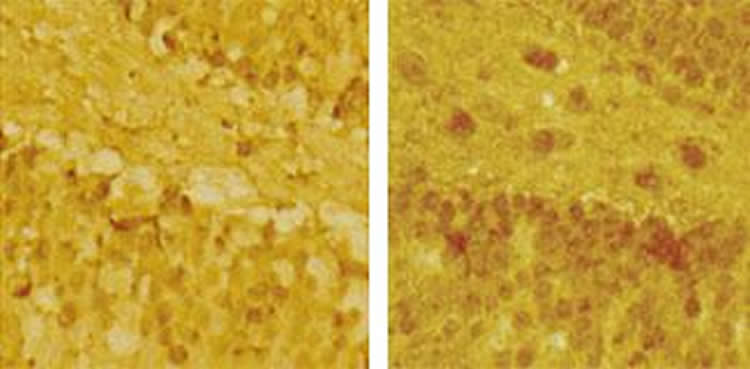Chronic stress can lead to changes in neural circuitry that leave the brain trapped in states of anxiety and depression. But even under repeated stress, brief opportunities for recovery can open up, according to new research at The Rockefeller University.
“Even after a long period of chronic stress, the brain retains the ability to change and adapt. In experiments with mice, we discovered the mechanism that alters expression of key glutamate-controlling genes to make windows of stress-related neuroplasticity–and potential recovery–possible,” says senior author Bruce McEwen, Alfred E. Mirsky Professor, and head of the Harold and Margaret Milliken Hatch Laboratory of Neuroendocrinology. Glutamate is a chemical signal implicated in stress-related disorders, including depression.
“This sensitive window could provide an opportunity for treatment, when the brain is most responsive to efforts to restore neural circuitry in the affected areas,” he adds.
The team, including McEwen and first author Carla Nasca, wanted to know how a history of stress could alter the brain’s response to further stress. To find out, they accustomed mice to a daily experience they dislike, confinement in a small space for a short period. On the 22nd day, they introduced some of those mice to a new stressor; others received the now-familiar confinement.
Then, the researchers tested both groups for anxiety- or depression-like behaviors. A telling split emerged: Mice tested shortly after the receiving the familiar stressor showed fewer of those behaviors; meanwhile those given the unfamiliar stressor, displayed more. The difference was transitory, however; by 24 hours after the final stressor, the behavioral improvements seen in half of the mice had disappeared.
Molecular analyses revealed a parallel fluctuation in a part of the hippocampus, a brain region involved in the stress response. A key molecule, mGlu2, which tamps down the release of the neurotransmitter glutamate, increased temporarily in mice subjected to the familiar confinement stress. Meanwhile, a molecular glutamate booster, NMDA, increased in other mice that experienced the unfamiliar stressor. In stress-related disorders, excessive glutamate causes harmful structural changes in the brain.
The researchers also identified the molecule regulating the regulator, an enzyme called P300. By adding chemical groups to proteins known as histones, which give support and structure to DNA, P300 increases expression of mGlu2, they found.

In other experiments, they looked at mice genetically engineered to carry a genetic variant associated with development of depression and other stress-related disorders in humans, and present in 33 percent of the population.
“Here again, in experiments relevant to humans, we saw the same window of plasticity, with the same up-then-down fluctuations in mGlu2 and P300 in the hippocampus,” Nasca says. “This result suggests we can take advantage of these windows of plasticity through treatments, including the next generation of drugs, such as acetyl carnitine, that target mGlu2–not to ‘roll back the clock’ but rather to change the trajectory of such brain plasticity toward more positive directions.”
Source: Katherine Fenz – Rockefeller University
Image Source: The image is credited to Laboratory of Neuroendocrinology at The Rockefeller University/PNAS
Original Research: Abstract for “Stress dynamically regulates behavior and glutamatergic gene expression in hippocampus by opening a window of epigenetic plasticity” by Carla Nasca, Danielle Zelli, Benedetta Bigio, Sonia Piccinin, Sergio Scaccianoce, Robert Nisticò, and Bruce S. McEwen in PNAS. Published online November 16 2015 doi:10.1073/pnas.1516016112
Abstract
Stress dynamically regulates behavior and glutamatergic gene expression in hippocampus by opening a window of epigenetic plasticity
Excitatory amino acids play a key role in both adaptive and deleterious effects of stressors on the brain, and dysregulated glutamate homeostasis has been associated with psychiatric and neurological disorders. Here, we elucidate mechanisms of epigenetic plasticity in the hippocampus in the interactions between a history of chronic stress and familiar and novel acute stressors that alter expression of anxiety- and depressive-like behaviors. We demonstrate that acute restraint and acute forced swim stressors induce differential effects on these behaviors in naive mice and in mice with a history of chronic-restraint stress (CRS). They reveal a key role for epigenetic up- and down-regulation of the putative presynaptic type 2 metabotropic glutamate (mGlu2) receptors and the postsynaptic NR1/NMDA receptors in the hippocampus and particularly in the dentate gyrus (DG), a region of active neurogenesis and a target of antidepressant treatment. We show changes in DG long-term potentiation (LTP) that parallel behavioral responses, with habituation to the same acute restraint stressor and sensitization to a novel forced-swim stressor. In WT mice after CRS and in unstressed mice with a BDNF loss-of-function allele (BDNF Val66Met), we show that the epigenetic activator of histone acetylation, P300, plays a pivotal role in the dynamic up- and down-regulation of mGlu2 in hippocampus via histone-3-lysine-27-acetylation (H3K27Ac) when acute stressors are applied. These hippocampal responses reveal a window of epigenetic plasticity that may be useful for treatment of disorders in which glutamatergic transmission is dysregulated.
“Stress dynamically regulates behavior and glutamatergic gene expression in hippocampus by opening a window of epigenetic plasticity” by Carla Nasca, Danielle Zelli, Benedetta Bigio, Sonia Piccinin, Sergio Scaccianoce, Robert Nisticò, and Bruce S. McEwen in PNAS. Published online November 16 2015 doi:10.1073/pnas.1516016112






